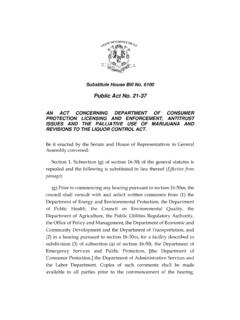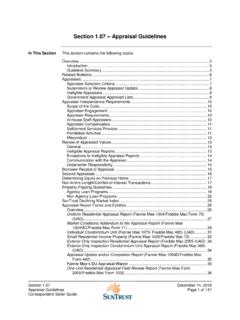Transcription of Understanding the Appraisal
1 Understanding the AppraisalUnderstanding the AppraisalMuch of the private, corporate and public wealth of the world consists of real estate . The magnitude of this fundamental resource creates a need for informed appraisals to support decisions pertaining to the use and disposition of real estate and the rights inherent in ownership. An Appraisal answers one or more specific questions about a real estate parcel s value, marketability, usefulness or suitability. The Appraisal Defined Professional real estate appraisers perform a useful function in society and offer a variety of services to their clients. They develop opinions of several types of property value and assist in various decisions about real estate . Standards for the Appraisal profession are set forth in the Uniform Standards of Professional Appraisal Practice (USPAP) developed by the Appraisal Standards Board of The Appraisal Foundation.
2 * USPAP specifies the procedures to be followed in developing and communicating an Appraisal and the ethical rules for Appraisal practice. As defined in USPAP, an Appraisal is the act or process of developing an opinion of value. The valuation process is a systematic procedure the appraiser follows to answer a client s question about real property most common type of Appraisal assignment is the development of an opinion of market value. However, because of their specialized training and experience, appraisers can provide a wide range of additional Appraisal services from investment consultation to advice on various business as well as personal financial decisions.* Intended Use of an AppraisalAn Appraisal may be requested or required for many reasons. To facilitate the transfer of ownership of real property To help prospective sellers determine acceptable selling prices or prospective buyers decide on offering prices To establish a basis for the exchange or reorganization of real property or for merging the ownership of multiple propertiesMany Appraisal assignments relate to financingand credit.
3 To assist the underwriter in establishing a value of security for a mortgage loan To provide an investor with a sound basis for the purchase of real estate mortgages, bonds or other types of securitiesOther appraisals are requested to help resolve legalor tax issues. To estimate the market value of a property in eminent domain proceedings To estimate the market value of a property in contract disputes or as part of a portfolio To estimate the market value of partnership interests To estimate damages created by environmental contamination To estimate assessed value To determine gift or inheritance taxes To estimate the value of the real property component of an estate4 Appraisals are also used in investment counselingand decision-making.
4 To set rent schedules and lease provisions To determine the feasibility of a construction or renovation program To aid in corporate mergers, issuance of stock or revision of book value To estimate liquidation value for forced-sale or auction proceedings To counsel a client on investment matters, including goals, alternatives, resources, constraints and timing To advise zoning boards, courts and planners, among others, regarding the probable effects of proposed actions To arbitrate between adversariesAppraisals for the Lending IndustryMany appraisals are performed for lending purposes. Property owners should be aware that current federal lending regulations* require the lender to initiate the Appraisal . The lender must have the first contact with the appraiser and oversee the Appraisal process.
5 According to these regulations, the lender must be the client and the appraiser must be engaged by the lending institution. Any property owner who wants to use the Appraisal for lending purposes should communicate this need to the lender and have the lender engage the appraiser . This avoids the possibility of the lender rejecting the Appraisal or requiring a new Appraisal because the Appraisal was not initiated by the bank. According to federal lending laws, any bank can use an Appraisal prepared for another bank, as long as the initiating bank reviews the Appraisal and finds it to be acceptable.*Interagency Appraisal and Evaluation Guidelines, October 27, 1994, and Independent Appraisal and Evaluation Functions, October 27, 2003 ; InfluencesThe analysis of social, economic, governmental and environmental forces provides an Understanding of the dynamics of change and helps identify value trends.
6 Against this background, the appraiser investigates the characteristics of the subject property that might impact the property s value. The appraiser also investigates the nature of the market for that property, competitive properties, and the buyers and sellers who constitute the market for that property type. The principles of supply and demand, substitution, balance and externalities help explain shifts in independent economic factors utility, scarcity, desire, and effective purchasing power must be present to create value in a particular item or collection of items. Professional Appraisal standards specifically require the study of all value influences. Change and anticipation are fundamental, and appraisers apply these principles and related concepts that influence value in their to ValueParticipants in the real estate market commonly think of value in three ways: The current cost of reproducing or replacing a building, minus an estimate for depreciation, plus the value of the land (and entrepreneurial incentive, if applicable) The value indicated by recent sales of comparable properties in the market The value that the property s net earning power will support6 These different viewpoints form the basis of the three approaches that appraisers use to value property the cost, sales comparison and income capitalization approaches.
7 One or more of these approaches may not be applicable to a given assignment or may be less significant because of the nature of the property, the Appraisal problem or the data available. The approaches to value are applied within the context of the valuation Valuation ProcessAlthough characteristics of properties differ widely, all Appraisal problems can be solved through the systematic application of the valuation process. In the valuation process the problem is identified, the work necessary to solve the problem is planned and relevant data is collected, verified and analyzed to form an opinion of valuation process is accomplished by following specific steps, the number of which depends on the nature of the Appraisal assignment and the data available to complete it.
8 In all cases, however, the valuation process provides the model to be followed in performing market research and data analysis, in applying Appraisal techniques and in integrating the results of these analytic activities into an opinion of and intended usersIntendedusePurpose of the assignment (type of value) Relevant characteristicsof the propertyExtraordinaryassumptionsEffectiv e date ofthe opinionIdentification of the ProblemScope of Work DeterminationData Collection and Property DescriptionMarket Area DataGeneral characteristicsof region, city, andneighborhoodSubject Property DataSpecific characteristics ofland and improvements,personal property, businessassets, Property DataSales, listings, offerings,vacancies, cost anddepreciation, income andexpenses, capitalizationrates.
9 AnalysisMarket AnalysisDemand studiesSupply studiesMarketability studiesHighest and Best Use AnalysisSite as though vacantIdeal improvementProperty as improvedSite Value OpinionApplication of the Approaches to ValueCostSales ComparisonIncome CapitalizationReconciliation of Value Indications and Final Opinion of ValueReport of Defined ValueAssignment ConditionsIdentification of the ProblemThe first step in the valuation process is to identify the problem. This sets the parameters of the assignment and eliminates any ambiguity about the nature of the assignment. In this step the appraiser identifies the client and intended users of the Appraisal , the intended use of the Appraisal , the purpose of the assignment, the effective date of the opinion, the relevant property characteristics and the assignment conditions (extraordinary assumptions or hypothetical conditions).
10 Scope of Work DeterminationThe scope of work is the amount and type of information researched and the analyses applied in an assignment. After the problem to be solved is clearly identified, the appraiser must next determine the appropriate scope of work to solve the problem. The scope of work must be clearly disclosed in the Appraisal Collection and Property DescriptionIn this step the appraiser gathers general data on the market area and specific data on the subject and comparable properties. The appraiser collects general data related to property values in an area to understand the economic climate in which properties compete and the interacting forces that cause values to increase, decrease or remain stable. Specific data are details about the property being appraised (the subject property) and comparable properties that have been sold or leased in the local market.













